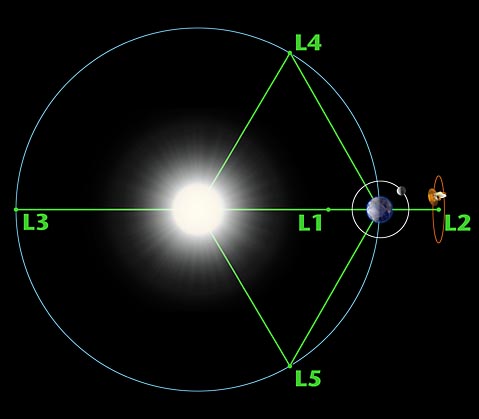|
|
|

The Earth/Sun Lagrange points with an L2
Lissajous orbit illustrated. Credit: NASA.
The Planck Mission
Mar 16, 2010
Third try pays for all.
On May 19, 2009, the European Space
Agency (ESA)
launched both Planck and the
Herschel Long-Wavelength Space
Observatory together on top of an
Ariane 5 delivery system. Both
spacecraft entered orbit around
Lagrange point L2 and began
operations a short time ago.
Although each is a separate mission,
their individual placement at L2
made it more efficient to launch
them as a combined package.
The five Lagrange points shown above
represent two stable and three
unstable positions. L4 and L5 are
stable: an object placed there will
remain in position indefinitely,
with no need for periodic orbital
adjustments. L1 offers a clear view
of the Sun, so the Solar and
Heliospheric Observatory Satellite (SOHO)
was placed there. The Wilkinson
Microwave Anisotropy Probe (WMAP),
on the other hand, occupied L2
because it places Earth between it
and the solar disk, which is why
Planck has also been set in that
location. Later, in 2014, L2 will be
occupied by the
James Webb space telescope, as
well.
Planck is designed to analyze the
cosmic microwave background
radiation (CMBR) with greater
precision than either of its
predecessors, the Cosmic Background
Explorer (COBE) and WMAP. COBE is no
longer operational, but WMAP
continues to scan the sky. However,
is WMAP providing accurate
information, and is the recent map
showing the distribution of
temperatures in the early Universe
nothing but an illusion?
The
Wilkinson Microwave Anisotropy Probe
(WMAP) was launched June 30,
2001, from Cape Canaveral in an
attempt at understanding some
unusual telemetry returned by COBE
in 1992. Big Bang theory does not
account for the areas of anisotropy
seen first by COBE because matter
and energy should be evenly
distributed. The WMAP survey
verified COBE's results.
In a previous Picture of the Day, we
quoted EU theorist
Wal Thornhill:
"If Arp and others are right and the
Big Bang is dead, what does the
Cosmic Microwave Background signify?
The simplest answer, from the highly
successful field of plasma
cosmology, is that it represents the
natural microwave radiation from
electric current filaments in
interstellar plasma local to the
Sun... Instead of the Cosmic
Microwave Background, it is the
Interstellar Microwave Background.
That makes sense of the fact that
the CMB is too smooth to account for
the lumpiness of galaxies and
galactic clusters in the universe."
So, in reality, there is no
temperature fluctuation from the
earliest days of the universe
shining in microwaves down from the
heavens. However, the problems with
CMB measurements from COBE and WMAP
are far greater than we considered
in that previous article. Coupled
with previous observations by
Thornhill and others, the CMBR
appears to get most of its energy
signature from a rather surprising
place: Earth itself.
According to
papers recently published by
Pierre-Marie Robitaille of Ohio
State University's Department of
Radiology, many oversights and
offhanded errors crept in to the
data from WMAP. The team did not
fully calibrate the FIRAS
spectrophotometer before launch,
many possible error sources in the
calibration protocol were zeroed
out, and no account was taken of
thermal emissions from Earth's
oceans—which turns out to be the
likely source of so-called "cosmic"
microwave radiation.
Quoting the WMAP critique:
"All of the cosmological constants
which are presented by the WMAP team
are devoid of true meaning,
precisely because the images are so
unreliable. Given the tremendous
dynamic range problems, the
inability to remove the galactic
foreground, the possibility of
generating galactic ghosts through
'cleaning', the lack of signal to
noise, the lack of reproducibility,
the use of coefficients which
fluctuate on a yearly basis, and the
problem of monitoring results on a
cosmological timescale, attempts to
determine cosmological constants
from such data fall well outside the
bounds of proper image
interpretation."
Stephen Smith
|
|
|
|
|
|
|
|
|
YouTube video, first glimpses of Episode Two in the "Symbols of an Alien Sky"
series.
|
|
|
|
|
|
|
Three ebooks in the Universe Electric series are
now available. Consistently
praised for easily understandable text and exquisite graphics.
|
|
|
|
|
|
|
|
|
|







